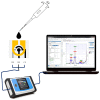Fabric-Based Electrochemical Glucose Sensor with Integrated Millifluidic Path from a Hydrophobic Batik Wax
- PMID: 37447683
- PMCID: PMC10346911
- DOI: 10.3390/s23135833
Fabric-Based Electrochemical Glucose Sensor with Integrated Millifluidic Path from a Hydrophobic Batik Wax
Abstract
In recent years, measuring and monitoring analyte concentrations continuously, frequently, and periodically has been a vital necessity for certain individuals. We developed a cotton-based millifluidic fabric-based electrochemical device (mFED) to monitor glucose continuously and evaluate the effects of mechanical deformation on the device's electrochemical performance. The mFED was fabricated using stencil printing (thick film method) for patterning the electrodes and wax-patterning to make the reaction zone. The analytical performance of the device was carried out using the chronoamperometry method at a detection potential of -0.2 V. The mFED has a linear working range of 0-20 mM of glucose, with LOD and LOQ of 0.98 mM and 3.26 mM. The 3D mFED shows the potential to be integrated as a wearable sensor that can continuously measure glucose under mechanical deformation.
Keywords: chemical and biological sensor; continuous glucose monitoring; fabric-based; millifluidic devices and lab-on-chip devices; sensor testing and evaluation; stencil printing.
Conflict of interest statement
The authors declare that there are no competing interests.
Figures









References
-
- Taub M., Bugler J., Peyser T. Analyte Monitoring and Management Device and Method to Analyze the Frequency of User Interaction with the Device. 8,160,900. U.S. Patent. 2012 April 17;
-
- Promphet N., Hinestroza J.P., Rattanawaleedirojn P., Soatthiyanon N., Siralertmukul K., Potiyaraj P., Rodthongkum N. Cotton thread-based wearable sensor for non-invasive simultaneous diagnosis of diabetes and kidney failure. Sens. Actuators B Chem. 2020;321:128549. doi: 10.1016/j.snb.2020.128549. - DOI
-
- Promphet N., Rattanawaleedirojn P., Siralertmukul K., Soatthiyanon N., Potiyaraj P., Thanawattano C., Hinestroza J.P., Rodthongkum N. Non-invasive textile based colorimetric sensor for the simultaneous detection of sweat pH and lactate. Talanta. 2019;192:424–430. doi: 10.1016/j.talanta.2018.09.086. - DOI - PubMed
-
- Xiao G., He J., Chen X., Qiao Y., Wang F., Xia Q., Yu L., Lu Z. A wearable, cotton thread/paper-based microfluidic device coupled with smartphone for sweat glucose sensing. Cellulose. 2019;26:4553–4562. doi: 10.1007/s10570-019-02396-y. - DOI
MeSH terms
Substances
LinkOut - more resources
Full Text Sources
Miscellaneous

